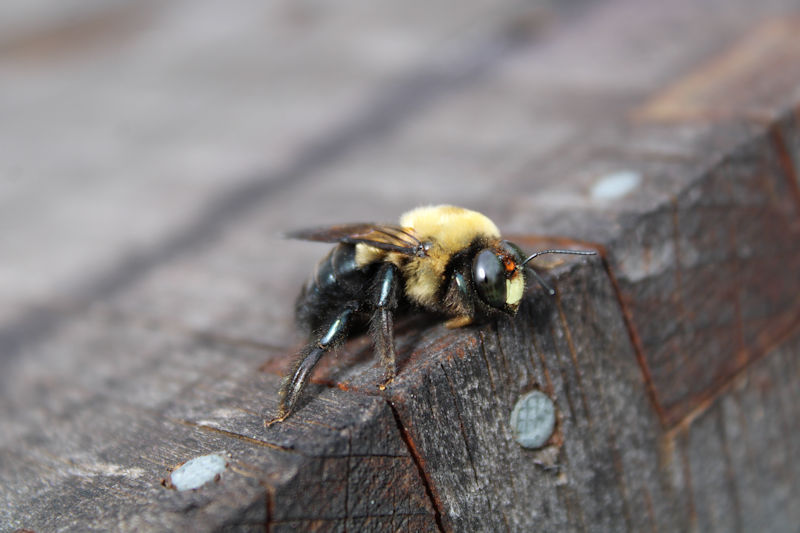Carpenter bees, common in Southern Maryland and Northern Virginia, are best known for boring into wood. These large, fuzzy, bumblebee-like insects excavate tunnels in wood to nest. While they don’t eat wood, their presence can seriously damage your home, especially untreated wooden materials. Learning how to prevent a carpenter bee infestation is key to protecting your home.
Locating Where Carpenter Bees Live
Carpenter bees prefer untreated or weathered wood for nesting. Their typical sites include eaves, fascia boards, wooden siding, and outdoor furniture. Identifying an infestation early makes it easier to protect your home.
Common Nesting Sites
- Untreated or weathered wood
- Eaves
- Fascia boards
- Wooden siding
- Outdoor furniture
How to Spot Carpenter Bees
- Round holes in wood
- Sawdust piles below the holes
- Bees hovering near wooden structures
Steps to Prevent Carpenter Bee Infestations
- Seal Entry Points
Sealing cracks and holes in wooden structures is one of the best ways to avoid carpenter bees.
Follow these steps:
- Point of entry: Inspect wooden structures, particularly eaves and fascia boards, for cracks or holes.
- Clean the cracks: Clear out debris or sawdust from around the area.
- Seal the gaps: Fill gaps with caulk or wood putty, matched to the wood’s color for a seamless look.
- Protect larger areas: Cover heavily infested spots or larger cracks with metal screens.
Recommended Materials
- Caulk
- Wood putty
- Metal screens
- Treat Wood Surfaces
Applying a protective finish to wood makes it less attractive for carpenter bees to burrow. Options like paint, varnish, and stains can provide a solid defense.
Types of Treatments:
- Paint: A durable, protective coating. Apply multiple layers for added protection.
- Varnish: A clear, hard finish. Use an exterior-grade product for outdoor areas.
- Stains with Sealants: Protect wood from the inside out. Look for products with built-in sealants.
How to Apply:
- Clean the wood surface before application.
- Use a brush or sprayer to ensure even coverage.
- Reapply as necessary, especially in high-traffic or weather-exposed areas.
- Install Physical Barriers
Physical barriers can keep carpenter bees from nesting in vulnerable areas. Opt for materials like mesh screens or use bee-resistant building materials.
Barrier Options:
- Mesh screens and netting: Cover eaves, soffits, and wooden outdoor furniture.
- Bee-resistant materials: Replace wood with vinyl siding or aluminum trim, which are durable and insect-proof.
Why You Should Avoid Carpenter Bee Infestations
Keeping carpenter bees away from your home not only protects wood structures but also saves you from costly repairs. Regular inspections and proactive maintenance are essential for homeowners in Southern Maryland and Northern Virginia.
Carpenter Bee Prevention Top Tips
- Regularly inspect wood structures for signs of activity.
- Treat and seal wood surfaces to deter nesting.
- Add physical barriers like screens or resistant materials for extra protection.
FAQs
Q: Why is my house a target for carpenter bees?
A: Carpenter bees are attracted to untreated or weathered wood. Regularly treating wood can help keep them away.
Q: Are carpenter bees harmful?
A: They rarely sting, but their burrowing can weaken wooden structures, leading to significant damage over time.
Q: How do I know if carpenter bees are present?
A: Look for round holes, piles of sawdust, and bees hovering near wooden areas.
Q: How do you best seal carpenter bee holes?
A: Fill the holes with wood putty or caulk. For larger areas, metal screens are effective.
Q: How often should I treat wood to prevent carpenter bees?
A: Every few years or as needed. Areas exposed to weather or heavy use may need more frequent treatment.
References
NEED HELP?
If you live in Southern Maryland, or Northern Virginia
FIND YOUR SOLUTION HERE
People, Pet & Pollinator Safe! Pest control for people who care.
